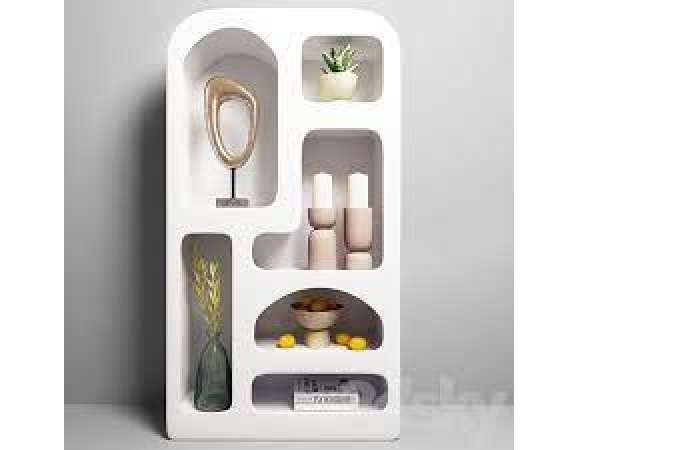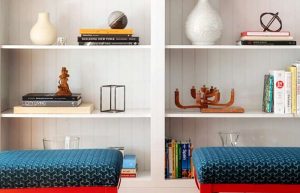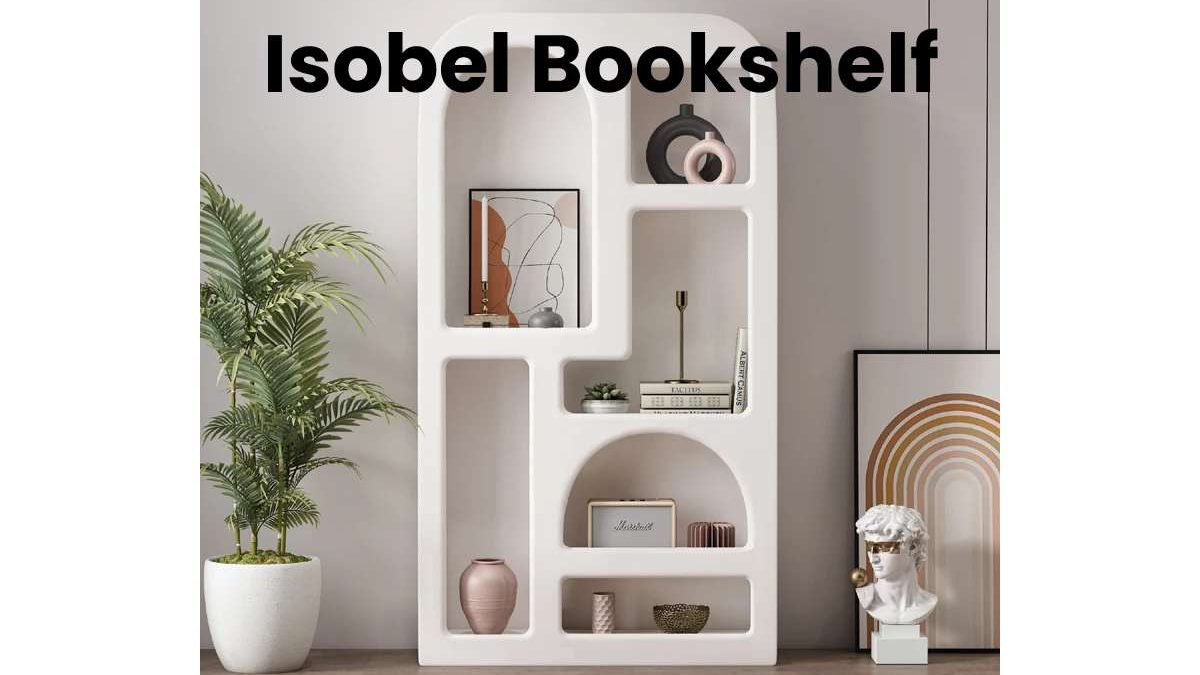Isobel Bookshelf – A bookcase, or bookshelf, is a thing of furniture with flat retirement, frequently in a bureau, used to store books or other pieces of literature. Shelves utilize in confidential, school, college libraries, workplaces, and book shops. Bookshelves range from little, low models at the table level to high ones at the roof level. Racks might be fixed or flexible to various situations.
In addition to this, In rooms dedicated to the capacity of books, for example, libraries, they might be set to the walls and floor for all time.
Accordingly, It might fit on a shelf with glass doors that can shut to shield the books from residue or dampness. Shelf entryways are often frosted with glass, permitting the spines of the books to peruse. Might keep essential uncommon books in locked cases with wooden or coated entries. A little shelf may likewise remain on another household item like a work area or chest.
More over, essential books are bound to be in level heaps, and enormous books are on wide retires or end tables.
Here, In Latin and Greek, the possibility of a cabinet addressed by Bibliotheca and Bibliothēkē (Greek: βιβλιοθήκη), subordinates of which mean library in numerous cutting-edge dialects. A shelf is otherwise called a shelf, a bookstand, a pantry and a bookrack. In a library, massive shelves classify”stacks.”
Table of Contents
Designers and Manufacturers Isobel Bookshelf

Nowhere, Chippendale and Sheraton made or planned numerous cabinets, generally coated with little capsules encased in fretwork outlines, frequently of extraordinary appeal and tastefulness. Accordingly to some, the finesse of a portion of Sheraton’s satinwood bookshelves seldom has equal.
Whereas, The French cabinetmakers of a similar period were exceptionally effective with few decorative cases. Mahogany, rosewood satinwood and, surprisingly, choicer extraordinary woods utilize; the frequently decorated with marquetry and mounted with pursued and plated bronze. Habitually wrapped up Bantam shelves with a section of decision marble at the top.
Firstly, In 1876, John Danner of Canton, Ohio, developed a spinning bookshelf with a licensed “turn and post” plan. The creativity of his work lived in the economy of room it gave. Thirty-two volumes of the American Cyclopedia could be put away in a conservative space and promptly accessible for scrutiny at bit of finger.
Secondly, Danner’s shelf showed up in the 1894 Montgomery Ward list. In 1878 he displayed his cabinets at the Paris International Exhibition and won a gold decoration. The John Danner Manufacturing Company was known for outstanding craft and reasonableness. The forest was oak, dark pecan, western debris, and Philippine mahogany. He sees as a dynamic financial specialist, and Danner is official with withdrawing a considerable exchange and business to the city of Canton.
Library Shelving
Moreover, In the extraordinary public libraries of the 20th 100 years, staggered stacks frequently filled in as both design and shelving, of iron, as British Museum where the racks cover with cowhide; or steel, as in the Library of Congress in Washington, D.C.; or of record, as in the Fitzwilliam Library at Cambridge
When was first Bookshelf made?
Twelve oak bookcases made for diarist Samuel Pepys is earliest dates domestic examples. The first was install in August 1666 and now in the Pepys Library at Magdalene College, Cambridge.
Who invented the Shelves?
Here, Archaeological evidence suggests that shelves were first invented by the Roman inventor Gnaius Shelficus in 4AD. But unfortunately, his invention was destroyed by Gauls and would reinvent until 1983 by Bjorn Ikea.
What is the purpose of a Bookshelf?
Additionally, Shelves give a feeling of association to, indeed, books of every kind imaginable yet additionally can give space to different things like photo placements, beautifications, or memorabilia you wish to flaunt to guests. They come in a wide range of shapes and sizes themselves.
What is the difference between a Bookcase and a Isobel Bookshelf?

Meanwhile, A bookcase is a close-sided unit that encases books and is plan to sit on the floor, while bookshelf does not have covered ends and arranged to hang on a wall. Bookcases is more traditional than bookshelves and often installed as permanent recessed fixtures in a home because they’re large, heavy pieces of furniture.
In such a way contrast, bookshelves are not usually permanent fixtures. They also tend to be more modern in style because they composed of floating or stacked shelves. Because bookshelves don’t have encased ends, they require bookends to keep books upright.
Since, they don’t have a frame, bookshelves weigh substantially less than bookshelves. For this reason, it is common to find large bookshelf units that span an entire wall.
Different Types of Bookcases of Isobel Bookshelf
Nowhere, If you have books stacked on tables and floors and double-deep on bookshelves, those books need a roomy home. Many types and styles of bookcases are available today, and much different woodworking plans to build your own.
Further more, They come in a variety of colours, sizes, and styles.It can make different materials, from wood, metal, and plastic. Some made with glass fronts to protect books from dust. They can be built-in, freestanding, or foldable.
1.Barrister Bookcases
Barrister bookcases originated in England and have designs for barristers’ use. This bookcase became popular because of its unique stackable design.
Barristers had many law books, which was a problem if they had to move to new chambers.
2. Modular Bookcases
Can use cubes with or without backs on walls to display decorative pieces or books. It come in small or large and used individually or in groups, in various creative ways with endless configurations and possibilities for the design guru. They can stack horizontally or vertically, used to create a traditional-looking bookcase, or can put cubes together to make room dividers. The modular parts can be cubes that slide or snap together to create a tall vertical or low horizontal unit.
3. Revolving and Corner Bookcases
These are sleek, space-saving, and eye-catching in a home. They can placed in unused areas and corners in a room to display books and treasures attractively.
4. Ladder and Leaning Bookcases
These resemble a ladder with shelves like rungs to hold books and other items. There are two types: freestanding or leaning. The bottom bracket is extensive, with shelf size decreasing with each rung and a minor shelf at the top. The ladder bookcase is usually triangular from the side with four feet for added stability. It is a sleek design and works great in tight spaces; there is even a corner model.
5. Isobel Books Shelf Bookcases
Accordingly, The most widely recognized type. They can be open or shut-supported, and the racks can be flexible or not, unattached or incorporated into the wall, two shelves, or more. These cabinets can utilized alone or with different units to make an enormous framework. That made from wood, metal, or plastic.
Youngsters’ bookshelves typically made more modest and in splendid tones. Some have racks separated further to oblige tall youngsters’ books, and they’re typically a form of plastic for simple cleaning.
6. Display Bookcase or Isobel Bookshelf
This type has dowels or a strip of wood along the edge to display books with their covers facing forward.
CONCLUSION
Atlast, When shopping for bookcases, consider the size of your book collection, space, budget, and if you will be moving a lot. Also, consider your skill with woodworking tools, as bookcases are popular woodcraft projects.
Finally, Look at How to Build a Bookcase at Popular Mechanics to build a basic bookcase.


